Clear, 75° F
Joseph — a magnificent stallion of colonial Spanish descent — followed his mares, keeping a wary eye on the horizon.
They were being pursued.
Bill Pickett, natural resources program manager for Bighorn Canyon National Recreation Area, was …
This item is available in full to subscribers.
The Powell Tribune has expanded its online content. To continue reading, you will need to either log in to your subscriber account, or purchase a subscription.
If you are a current print subscriber, you can set up a free web account by clicking here.
If you already have a web account, but need to reset it, you can do so by clicking here.
If you would like to purchase a subscription click here.
Please log in to continue |
|
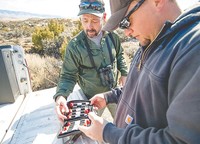
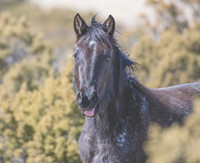
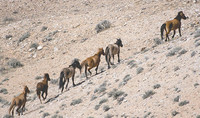
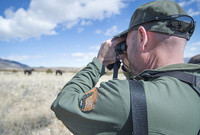
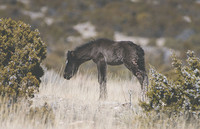

The four mares and a foal moved slowly as they browsed through Mustang Flats, with at least two ears up at all time.
Joseph — a magnificent stallion of colonial Spanish descent — followed his mares, keeping a wary eye on the horizon.
They were being pursued.
Bill Pickett, natural resources program manager for Bighorn Canyon National Recreation Area, was trying to get within 30 yards of a beautiful young mare known as Icara, hoping to hit her with a dart loaded with contraceptives. But the band knows Pickett.
He and Bureau of Land Management Range Technician Ryan Bradshaw usually put on several stalks a day, often covering 8 miles or more. They’re almost always alone on the stalks, watching for rattlers and hoping for a good shot at mares on their priority list.
Leery and lean from a long winter, the horses only paused shortly for occasional bites of grass and snow. It was a hike for Pickett to reach them near towering peaks west of Wyo. Highway 37 on the Montana side of the recreation area. As he closed in on the band, every step was placed with intent. And at every opportunity Pickett hot-footed it, stretching his stride, seemingly effortlessly, to reach surprising speeds through washes and across the rocky flats without startling the horses.
Tuesday was the first time Bradshaw and Pickett worked together, but they’ve been on the same mission since 2012 — working to administer the contraceptives to control the size of wild horse herds.
“A successful day for us is vaccinating one horse. Some days we only get one, some days seven. There’s more to it than people might think,” Pickett said.
Along with the BLM, the U.S. Forest Service and the National Park Service work together to help control numbers in the Pryor Mountain herd’s 30,000-acre range outside of Lovell; it runs through the Bighorn Canyon National Recreation Area, BLM land and the Bighorn National Forest.
The Appropriate Management Level (AML) for the Pryor herd is between 90-120 horses; the current official count is 155. While it’s too many, the problem is minor compared to most places in the country where wild horses thrive.
The AML for all of the habitat in the U.S. is about 26,000 horses, but there are more than 78,000. There are also more than 50,000 horses in the BLM’s long-term storage facilities, costing taxpayers tens of millions of dollars each year.
The BLM has the lead in the partnership. Jerrie Bertola, program leader for the BLM’s wild horse and burro program in Montana and South Dakota, is concerned about the growing problem.
“The population doubles every four years on a national level,” Bertola said.
Wyoming is considered to have a large population of wild horses, but it’s dwarfed by the number in Nevada, which has over half of the nation’s wild horses.
The Pryor Mountain herd is lucky. They have many fans and dedicated groups willing to help. “Cloud: Wild Stallion of the Rockies” — a popular documentary which first aired a decade ago — also brought national notoriety to the Pryor Mountain herd.
Bertola said it all started with locals.
“There’s a connection to the Pryor horses worldwide,” she said. “The local residents really had a connection to these horses and they drew people in with their experiences and stories.”
Their Spanish heritage also draws attention. The breed is known to be smaller, but hearty and intelligent. Visitors from across the globe plan trips to the U.S. around seeing the Pryor Mountain wild horses, Bertola said.
“If you were to look at all the herds that we have, this is the herd that people are going to have heard about,” Bertola said.
Pickett and Bradshaw know the horses so well they know the animals by name. With the mention of each horse, the pair can tell you stories which speak to individual personalities.
Mile after mile, rain and shine, Pickett and Bradshaw walk the rugged terrain. Dried sagebrush limbs, twisted and sun-bleached, crack like they haven’t seen moisture in decades. Sharp rocks and plains prickly pears menace with every step.
Pickett is like a billy goat. The only sign of fatigue at the end of the day are white salt stains of evaporated sweat on his jacket. His step is light and quick. He walks and stops, watching for opportunities to make up distance between he and his target, all the while trying not to stress the horses.
On the Montana side of the Bighorn Canyon National Recreation Area, Joseph led his newly formed band on Tuesday.
Johnston, a recently defeated stallion, fed alone peacefully in the nearby flats.
Sorcerer, the foal in Joseph’s band, had a large rip in the hide of his left hamstring. The colt seemed fatigued. Morgana, his mother, stayed close, nudging him to move whenever he rested. Sorcerer’s cut was likely caused by getting too close to fighting stallions, being in the wrong place at the wrong time. But mountain lions are also predators to the horses and the colt may just as easily been wounded escaping from being a meal.
Wolves are also considered predators, but none are known to predate herds in the Pryors. That could change. There have been several reported sightings of wolves near Lovell, and packs from the Yellowstone ecosystem are spreading fast. Humans are also considered predators. The BLM has the legal right to euthanize excess horses, but they don’t, Bertola said, due mostly to public opinion passionate about finding more humane ways to deal with the overpopulation problem.
Icara was the target of Tuesday’s second long stalk, with Pickett hoping to hit her with a dose of PZP. The immunocontraceptive vaccine has been studied for decades. It’s effective in controlling birth rates in many species, Bertola said. A naturally occurring protein, PZP is biodegradable and doesn’t pass through the food chain. In wild horses, the effects are reversible even after several consecutive years of treatment. The vaccination has no effect on ongoing pregnancies.
There may be easier ways to get horses rounded up for vaccinations, but the spot and stalk method is less stressful on the herd. Being shot with a dart in the haunches stings, but is far less painful than much the horses endure.
“It’s better than getting kicked, which happens often in these bands,” Pickett said.
Vaccinated mares have been found to live better, longer lives than those left untreated.
When the herd exceeds the AML by too many, individuals are selected from the bands for adoption. Those chosen are usually young and Pryor Mountain horses are popular.
“I get calls from around the country asking when these horses will be available for adoption,” Bertola said.
Colonial Spanish horses are known to develop special bonds with humans and are desired for their resilience.
Patty Martin, a biology technician at Bighorn Canyon and a Powell area resident, has adopted a few of the horses available in the past.
“They are easier to train than domesticated horses. They know nothing of humans other than what you show them. And they love attention — being scratched and given their oats,” Martin said. “They develop a unique bond — an amazing connection.”
But adoptions aren’t enough to solve the overpopulation problem and hard choices will be needed in the future. Last year, 61 mares were vaccinated in the Pryor Mountain herd. The local herds are managed well, but the BLM is constantly seeking to improve on the vaccination program, Bertola said. Currently the agency is looking at changing the parameters of the program, which typically targets mares until they’re at least 5 years old.
“The public seems to be supportive of proposed changes,” Bertola said.
The BLM is always seeking volunteers to help the Wild Horse and Burro Program. There are several ways to volunteer, including helping with adoption events, mentoring new adopters and conducting compliance checks to make sure newly adopted animals are in good care.